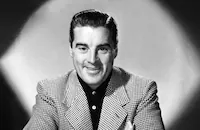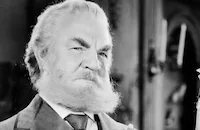Dames

Brief Synopsis
Cast & Crew
Ray Enright
Joan Blondell
Dick Powell
Ruby Keeler
Zasu Pitts
Guy Kibbee
Film Details
Technical Specs

Synopsis
Horace P. Hemingway, his wife Mathilda, and daughter Barbara, will inherit ten million dollars from Mathilda's eccentric cousin Ezra Ounce if their lives can pass Ezra's moral scrutiny. Unfortunately, Barbara is in love with Jimmy Higgens, a black sheep member of the Ounce family and an aspiring actor. Their chances of meeting Ezra's requirements are further jeopardized by Mabel Anderson, a showgirl who blackmails Horace after she sleeps in his train compartment. Horace, innocent of any indiscretion, but afraid of losing Ezra's millions, pays off Mabel. With Horace's money, Mabel and Jimmy put on a lavish Broadway musical, featuring Barbara. Meanwhile, Ezra has formed the Ounce Foundation for the Elevation of American Morals and plans to stop the indecent show on opening night by hiring a group of thugs to start a fight when he waves his handkerchief. As the curtain is about to go up, Barbara is delayed, and Mabel goes on in her place. Barbara finally arrives to take her role in the romantic number with Jimmy, but during the performance, Ezra, Horace and Mathilda get drunk on Ezra's health elixir. While Mabel is singing her next song, she waves to Ezra and he inadvertently waves back with his handkerchief. The fight breaks out on cue, the police arrive, and everyone except Mathilda lands in jail, happily drunk on elixir.

Director
Ray Enright
Cast

Joan Blondell

Dick Powell

Ruby Keeler

Zasu Pitts

Guy Kibbee

Hugh Herbert
Arthur Vinton

Phil Regan
Arthur Aylesworth
Johnny Arthur

Leila Bennett

Berton Churchill
Sammy Fain
Charles Williams
Frank Darien

Bess Flowers
Crew
George Barnes
Busby Berkeley
P. Burnett
Delmer Daves
Delmer Daves
Louis De Angelis
Gene Delaney
Mort Dixon
Al Dubin
John Ellis
Sammy Fain
F. Flanagan
Leo F. Forbstein
Lewis Geib
Al Green
Robert M. Haas
Sid Hickox
Stanley Jones
Irving Kahal
Jack Koffman
Robert Lord
Robert Lord
Warren Lynch
L. P. "dudie" Mashmeyer
Harold Mclernon
Harold Noyes
Howard Oggle
Orry-kelly
Willy Pogany
Sol Polito
George Satterfield
Sherry Shourds
Harry Warren
Allie Wrubel

Photo Collections
Videos
Movie Clip








Trailer
Hosted Intro
Film Details
Technical Specs

Articles
Dames - Dames
Wallis started out only knowing he wanted another musical starring Dick Powell and Ruby Keeler but it took him several screenwriters and a couple of screenplays before he had a story written to his satisfaction. Original director Archie Mayo was soon replaced by another director before the reins were handed over to Ray Enright a week before shooting began. From the beginning, however, the design and direction of the musical numbers was under the command of Busby Berkeley. The director/choreographer had his own unit by this time, operating under his complete control and with no supervision except for Wallis' sometimes stern eye on content and cost.
For Dames, however, Berkeley had a threat to his autonomy that was more powerful than Wallis or even the Warner Brothers. In the summer of 1934, the Motion Picture Production Code was toughened and strictly enforced after protests from Catholic groups. Among the targets of their attacks were the musicals of Busby Berkeley. In 42nd Street (1933) Berkeley sent his camera through the spread legs of scantily clad chorus girls and in Gold Diggers of 1933 he projected their naked silhouettes on screens.
One of the raciest numbers Berkeley planned for Dames never made it to the soundstage, much less past the Code's censors. Berkeley wanted Joan Blondell to perform a number about a battle between a cat and a mouse that would end with Blondell inviting all to "come up and see my pussy sometime." Wallis nixed this number completely in a memo he sent to Berkeley dated March 19, 1934: "we are accused of obscenity in our pictures enough as it is without reason, and besides there is no use besmirching the name of Berkeley with filth."
As a replacement, Berkeley devised a number with Blondell as "The Girl at the Ironing Board." Having Blondell behind an ironing board was not just an illustration of the song. At the time of shooting she was seven months pregnant and careful camerawork, handled by her husband, cinematographer George Barnes, was required to disguise her condition. All the attention on Blondell may have caused Berkeley to make a rare on-screen goof. He later recalled that after the picture opened: "over her right shoulder in the distance I see outside on the lawn where the clotheslines were hanging, one of my property men nailing up a clothesline. I had never noticed it, and no one else did until a week after the picture had opened."
Wallis put pressure on Berkeley to keep down costs, a request that caused Berkeley to bridle: "I was under pressure at the time to hurry up and finish on schedule. I could take any number I've done and elaborate on it, fifty percent more. But the front office was always thinking in terms of budget and expense."
Nevertheless, Dames is filled with great songs set to Berkeley stagings. The most famous, set to a Dick Powell-crooned "I Only Have Eyes For You," has chorus girls wearing Ruby Keeler masks, ultimately forming a giant Keeler face. The song remained a standard well into the rock 'n' roll era with hit versions by The Flamingos in the 1950's and Art Garfunkel in the 1970's.
Despite the new restrictions and a thin plot, Dames provides another wonderful showcase for one of Hollywood's greatest theatrical designers. Busby Berkeley bypassed the censors' shears and the front office's stinginess to create an exciting theatrical spectacle.
Director: Ray Enright, Busby Berkeley
Producer: Hal B. Wallis
Screenplay: Delmer Daves, Robert Lord
Cinematography: George Barnes, Sid Hickox, Sol Polito
Editor: Harold McLernon
Art Direction: Robert M. Haas, Willy Pogany
Music: Mort Dixon, Al Dubin, Sammy Fain, Irving Kahal, Harry Warren, Allie Wrubel Cast: Joan Blondell (Mabel Anderson), Dick Powell (Jimmy Higgins), Ruby Keeler (Barbara Hemingway), Zasu Pitts (Mathilde Hemingway), Guy Kibbee (Horace Hemingway), Hugh Herbert (Ezra Ounce).
BW-91m. Closed captioning.
by Brian Cady

Dames - Dames
Quotes
I'm free, white, and 21. I love to dance AND I'm going to dance.- Barbara Hemingway
Trivia
The studio wanted Broadway dancer Eleanor Powell for a special dance, but she refused the offer.
In the "Dames" number, 'Powell, Dick' as a Broadway producer doesn't want to see composer George Gershwin, but when asked by his secretary about seeing Miss Dubin, Miss Warren and Miss Kelly, he lets them enter his office. Al Dubin and Harry Warren wrote the music, and Orry-Kelly was costume designer of this picture.
Notes
The 1934 Wampus Baby Stars back up Joan Blondell in "The Girl at the Ironing Board" number. Studio records reveal that Warner Bros.' publicity department created the term "cinematerpsichorean" to describe Busby Berkeley's choreography, and that at the request of Hal Wallis, the characters "Johnny Harris" and "Buttercup Balmer" were named after two men who owned a string of theaters in Pennsylvania. According to studio records, Ruth Donnelly was considered for the role of "Mathilda" and Hobart Cavanaugh was considered for "Ellworthy Todd." According to a news item in Daily Variety, the studio had Berkeley's revolving stage design (also used in Gold Diggers of 1935) patented. Warner Bros. believed that if the stage design was protected by a patent, there would be little chance of other studios copying his technique which depended on the revolving stage. According to news items in Hollywood Reporter, Warner Bros. was sued by Goldwyn for using Berkeley, who had last worked for Goldwyn on his 1932 film The Kid from Spain. Berkeley claimed that Goldwyn secured his contract through misrepresentation and deceit, and therefore he could work where he wanted. No information was found regarding the outcome of the lawsuit. Modern sources add the following credits: Pat Harper, Ruth Etting, De Don Blunier, Gloria Faythe, Diana Douglas (Chorus girls); Lester Dorr (Elevator starter); Eddy Chandler (Guard); Harry Holman (Spanish War veteran); Fred "Snowflake" Toones (Porter); and Eddie Kane (Harry, the stage manager).
















